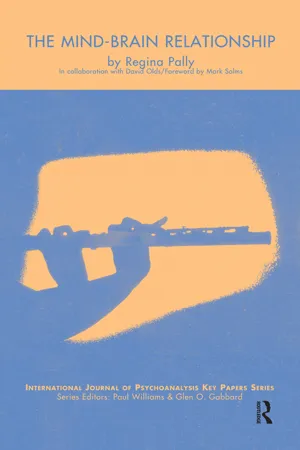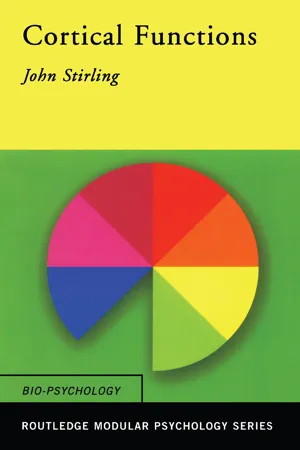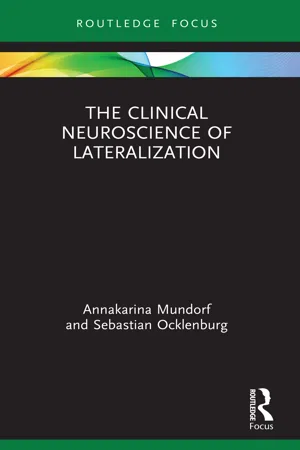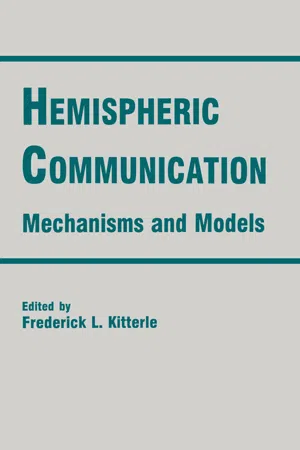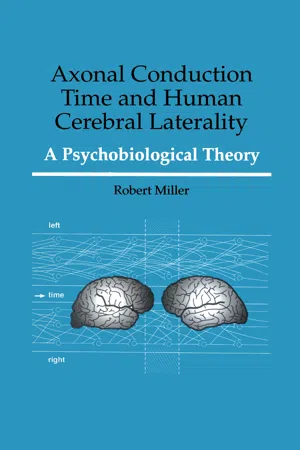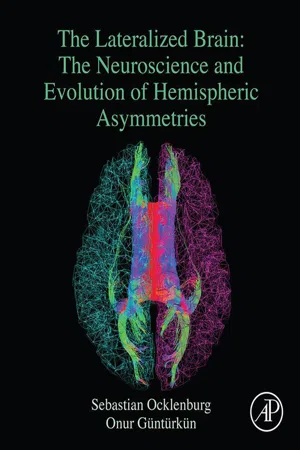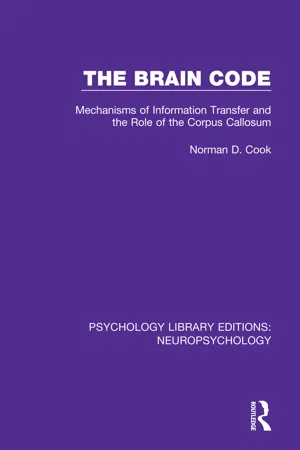Psychology
Lateralisation
Lateralisation refers to the specialization of functions in the two hemispheres of the brain. In the context of psychology, it is often associated with the idea that certain cognitive functions are more dominant in one hemisphere than the other. For example, language processing is typically lateralized to the left hemisphere, while spatial processing is more dominant in the right hemisphere.
Written by Perlego with AI-assistance
Related key terms
Related key terms
1 of 4
Related key terms
1 of 3
10 Key excerpts on "Lateralisation"
- eBook - ePub
- Regina Pally(Author)
- 2018(Publication Date)
- Routledge(Publisher)
In this century, in the 1930s, Lange revitalised interest in the central importance of the right hemisphere. He recognised that the right hemisphere provides a general contextual background to a person’s world view. During the 1960s the initial work of Sperry and Gazzaniga (Gazzaniga et al., 1962) at first seemed to corroborate the ‘two minds, two consciousnesses’ view held by some late nineteenth-century scientists. Subsequent work, however, resulted in the now generally accepted ‘asymmetric but integrated’ perspective. The right and left cerebral cortex are each lateralised for specialised functions, but in the healthy brain the two hemispheres share their information and operate collaboratively (Joseph, 1996; Deacon, 1997; Gazzaniga, 1995; Ornstein, 1997).Research regarding latéralisation of specialised functions pertains mostly to cortical functions. However, it must be remembered that specialised functions of each cortex are influenced by input from subcortical structures as well as from other cortical sites in the same or opposite hemisphere. According to Deacon, functional asymmetry evolved because in certain circumstances organisms must prioritise, and have only one goal, express only one action, or speak only one thought. For these particular functions only one hemisphere must have the advantage.Neuroscientists assume that the reason that language and fine motor movements are lateralised to the left cerebral cortex and emotion and musical ability to the right cerebral cortex is a fundamental difference between the left and right cortices with respect to information processing (Galin, 1974; Tucker, 1981). The left is better at analysing rapid temporal-sequential aspects of information. Therefore the left hemisphere more readily identifies ‘details’ and notices precise distinctions, rendering an advantage to the left in the specialised functions of language, causal relationships and fine motor movements. By contrast, the right is better at analysing the global, overall relationship aspects of information. Therefore the right more readily identifies context and gets the overall picture of the situation, giving an advantage to the right hemisphere in processing social interactions, emotional experience and visual-spatial tasks. One metaphor often used is that the left is a digital ‘computer’ and the right an analogue ‘computer. Another is that the left provides the ‘text’ and the right the ‘context’.Hemispheric dominance is relative, not absolute. Ornstein (1997) compares this to the ‘winner takes all’ in politics, where a 51 per cent majority can win the election. Translated into neuroscience this means a hemisphere does not function 100 per cent in its area of speciality, only relatively - eBook - ePub
- John Stirling(Author)
- 2020(Publication Date)
- Routledge(Publisher)
4Lateralisation
Introduction Structural differences The split brain syndrome Callosal agenesis Asymmetries in normal individuals What is lateralised? Inter-hemispheric transfer via the corpus callosum Individual differences in brain organisation SummaryIntroduction
As I mentioned in Chapter 2 , at first glance, the two cortical hemispheres look pretty much like mirror images of each other. Yet closer inspection reveals many subtle differences in structure. Behavioural studies suggest differences in function too. The study of Lateralisation is the study of the distinct patterns of psychological functioning seen in the two hemispheres. Hemispheric specialisation is also sometimes known as asymmetry of function because of the different (asymmetric) responsibilities that psychologists have observed. In this chapter, we consider the various ways that scientists have examined this asymmetry, and the conclusions that they have drawn from their research.Structural differences
The two hemispheres of the adult human brain are not mirror images of one another, and differ in a number of characteristic ways.• Viewed from the top of the head, the right frontal lobe extends further forward, and the left occipital lobe further back. • The dividing line between the frontal and temporal lobes (known as the Sylvian fissure) is longer and less sloped on the left side than the right. • A region of temporal lobe adjacent to the Sylvian fissure is much larger on the left than the right. This area of cortex has been linked to language comprehension for at least 100 years. - eBook - ePub
Brain, Attachment, Personality
An Introduction to Neuroaffective Development
- Susan Hart(Author)
- 2018(Publication Date)
- Routledge(Publisher)
In this chapter, I will review some aspects of lateralization and its importance for certain functions. The lateralization of the brain is an area of particular theoretical dispute, and much of the theory in the area is speculative in nature. It is, however, indisputable that the brain is lateralized, and hopefully, future research will be able to provide a clearer picture of the relationship between neurophysiological differences and function.History
As early as 1904, it was clear that the brain is not only lateralized on the neocortical level but also on a deeper level, in brainstem functions. The limbic system is also lateralized, and in the human brain emotional facial expressions are processed in the right hemisphere. Recent neurophysiological research shows that hemispheric lateralization is not just found in primate brains but is also a feature of lower mammals, fish, reptiles, birds, etc. The evolutionary advantage of brain lateralization has long been the topic of speculation, and today it is generally believed that lateralization has developed in order to make room for new skills without the loss of existing skills. Lateralization makes room for additional skills because functions can be divided between the right and left hemisphere, and the two hemispheres are free to specialize in different functions (Gazzaniga, 1999; Geschwind & Galaburda, 1987; Schore, 2003b).Some functions have had to give way to new ones. For example, the expansion of the parietal and frontal lobes probably took place at the cost of the visual cortex. A look at the skulls of some of the prehistoric humans who lived some two million years ago reveals that their skulls were constructed to accommodate a much larger visual cortex than is found in modern man. In particular, the frontal motor areas in the left hemisphere expanded at this time, while there are no major changes in the corresponding areas in the right hemisphere. This development probably took place in order to accommodate language, since this is the region where we find the neural roots of language (Gazzaniga, 1999; Hansen, 2002). - eBook - ePub
- Annakarina Mundorf, Sebastian Ocklenburg(Authors)
- 2021(Publication Date)
- Routledge(Publisher)
1 Lateralization in neurodevelopmental, psychiatric, and neurological disordersIntroduction
All mental processes are brain processes, and therefore all disorders of mental functioning are biological diseases. Eric Kandel (cited in Weir 2012)This statement by Nobel Prize laureate Eric Kandel exemplifies the key assumption of modern clinical neuroscience: the roots of mental illness lie in the disruption of biological processes in the brain. This implies that, in order to understand mental illness, it is crucial to understand how and why patients suffering from mental health problems show differences in brain organization compared to healthy individuals.One of the most important organizational features of the human brain (or any vertebrate brain for that matter) is its division into two halves, or hemispheres (Ocklenburg and Güntürkün 2018). While looking mostly symmetrical on the macrostructural level, the two hemispheres show countless left-right differences, so-called hemispheric asymmetries (see next section). Among the most intriguing empirical findings related to these hemispheric asymmetries is the fact that they show alterations in almost all of the investigated psychiatric and neurodevelopmental disorders (Ocklenburg et al. 2015). These include—to name the most common examples—dyslexia (Paracchini et al. 2016), schizophrenia (Gruzelier 1984), affective disorders (Hecht 2010), autism spectrum disorders (Lindell and Hudry 2013), posttraumatic stress disorder (Meyer et al. 2015), attention deficit hyperactivity disorder (Lin and Tsuang 2018), and alcohol use disorder (Zhu et al. 2018).Despite the wealth of the published literature (there are several hundred scientific papers on hemispheric asymmetries in schizophrenia alone), the relationship between hemispheric asymmetries and psychiatric and neurodevelopmental disorders is still far from being well understood. In particular, most empirical papers focus on hemispheric asymmetries in one specific disorder, but there rarely is an overarching integration of findings across different disorders. Therefore, the present book aims to not only review empirical findings on functional and structural hemispheric asymmetries in these and other disorders but also to integrate these findings across disorders. Moreover, we aim to synthesize the findings of the biological pathways that overlap between the ontogenesis of hemispheric asymmetries and the pathogenesis of different disorders. - eBook - ePub
Hemispheric Communication
Mechanisms and Models
- Frederick L. Kitterle(Author)
- 2020(Publication Date)
- Psychology Press(Publisher)
2 Neuroanatomical Bases of Hemispheric Functional Specialization in the Human Brain: Possible Developmental Factors 1 Sandra F. Witelson McMaster UniversityFunctional Asymmetry: Nature and Ontogeny
Hemispheric functional specialization or functional asymmetry is a well-established characteristic of functional organization in the human brain. In essence, the right and left hemispheres have different roles in mediating various behaviors and higher mental processes. Tasks involving speech production, phonemic discrimination; comprehension of oral and written language; the ability to write; performance of voluntary finger, limb, and oral movements; and the perception of sequences of stimuli are more dependent on left- than right-hemisphere functioning in most people. In contrast, tasks involving the perception of two- and three-dimensional visual or tactual shapes, spatial position and orientation of stimuli, the perception of faces and colors, mental rotation of three-dimensional shapes, the ability to direct attention to both lateral sensory fields, the perception of musical chords and melodies, aspects of the perception of emotional stimuli and prosodie features of speech, and the abilities to dress oneself and to construct block models are more dependent on the right hemisphere. In the past decade, numerous books have summarized these findings based on the study of brain-damaged people with unilateral lesions, people who have undergone commissurotomy, and neurologically intact people who were tested with various behavioral and perceptual tests involving right- and left-sided input or output (e.g., Beaton, 1985; Boller & Grafman, 1988-1990; Bradshaw & Nettleton, 1983; Bryden, 1982; Corballis, 1983; H. Damasio & A. Damasio, 1990; Geschwind & Galaburda, 1984; Hannay, 1986; Heilman & Valenstein, 1985; Heilige, 1983; Kolb & Whishaw, 1990; Molfese & Segalowitz, 1988; Ottoson, 1987).However, several key issues related to hemispheric specialization remain unresolved. First, the lists of tests that are more dependent on one hemisphere or the other are continually expanding. There is no demonstration, however, of what specific cognitive functions are common to each set of skills and are indicative of the type or types of processing that each hemisphere is specialized for. The numerous dimensions postulated for hemispheric differences, such as verbal versus nonverbal or analytic versus synthetic, are merely inferred hypotheses derived from the numerous tasks studied, of what the essential functional characteristics of the hemispheres are. Moreover, it has been shown that it is not only the nature of the task stimuli, but also the strategy or process the subject uses to perform the task, that determines which hemisphere is dominant in processing for that task. Currently, a widely used working hypothesis is that the left hemisphere is specialized for analytic, sequential, time-dependent functions, and the right hemisphere is specialized for synthetic, spatial perceptual functions (e.g., Bradshaw & Nettleton, 1983). - eBook - ePub
Neural Circuit and Cognitive Development
Comprehensive Developmental Neuroscience
- Bin Chen, Kenneth Y. Kwan(Authors)
- 2020(Publication Date)
- Academic Press(Publisher)
Shen, 2015 ). Again, this work is most meaningful when network features are linked to behavior.27.4.3.1. Lateralization
Lateralization, also referred to as hemispheric specialization or functional asymmetry, has been a historically popular explanation for cognitive sex differences, particularly for spatial and language skills. Typically, the left hemisphere, which houses both Broca's and Wernicke's areas, is dominant for sequential processing, including language, and the right hemisphere is dominant for simultaneous processing, including spatial skills (for reviews, see Bryden, 1982 ; Hall et al., 2008 ; Kansaku and Kitazawa, 2001 ; Kimura, 1999 ). Data going back several decades, derived from patients with brain damage and behavioral tasks in typical individuals (e.g., split-field visual tasks, dichotic listening, and electroencephalogram asymmetry), suggest that women are less lateralized than men, especially for language (Bryden, 1982 ; Gur and Gur, 2017 ; McGlone, 1980 ). The topic has also been studied using fMRI, but results are often task and method dependent and subject to misinterpretation. For instance, lateralization must be explicitly tested by comparing activation in the two hemispheres; it is not sufficient to show that the activity of only one hemisphere is above baseline or that there are significant sex differences in specific regions of a single hemisphere. When the correct analyses are conducted, women generally show less lateralization than men, but the effect is small. Women's reduced lateralization has been suggested to be linked to greater interhemispheric communication facilitated by their larger interhemispheric commissures and is consistent with data showing their greater interhemispheric structural connectivity (Halpern, 2012 ; Hines et al., 1992 ; Ingalhalikar et al., 2014 - eBook - ePub
Axonal Conduction Time and Human Cerebral Laterality
A Psycological Theory
- Robert Miller(Author)
- 2019(Publication Date)
- CRC Press(Publisher)
5 Perceptual Aspects of Lateralization: Theory and Predictions5.1 Introduction
From the morphological evidence reviewed above, the hypothesis that there be a richer repertoire of delay lines between different cortical areas in the left hemisphere compared to the right is at least plausible, though critical tests of the morphological aspects of the hypothesis have not yet been conducted. The evidence, such as it was, implied a global difference between the hemispheres, not confined selectively to the areas known to be primarily involved in language. This in turn has another major implication: It encourages us to think that the functional difference between the sides can be demonstrated not only with respect to language functions but with respect to a wide variety of other functions (both sensory and motor) which depend on the same lateralized differences in morphological substrate. Therefore, two further important questions are posed: What is the full range of functional differences between left and right hemispheres? Can they all be explained as direct or indirect consequences of differences between the hemispheres in the degree of temporal dispersion of signals within each hemisphere?In the present chapter, predictions will be made about the differences between the hemispheres in processing sensory signals, and in the following chapter corresponding evidence is reviewed. Admittedly, the hypothesis of the structural basis for interhemispheric differences also lends itself to predictions about differences in programming of motor output, and has implications for the higher cognitive functions of the forebrain. However, it is much easier to design experiments to evaluate temporal aspects of sensory processing than those of motor programming or cognitive processes. Discussion of the lateral differences in motor programming is therefore deferred to Chapters 8 and 9 , when they can be placed in an appropriate theoretical framework. Laterality of higher cognitive functions of the forebrain is discussed in Chapter 10 - eBook - ePub
The Lateralized Brain
The Neuroscience and Evolution of Hemispheric Asymmetries
- Sebastian Ocklenburg, Onur Güntürkün(Authors)
- 2017(Publication Date)
- Academic Press(Publisher)
While both research in split-brain patients and the results from the Wada test indicate that speech processing is impossible without the left hemisphere in most individuals, the notion that one hemisphere completely controls a complex cognitive function such as language processing is grossly oversimplified. Language processing is not one unified brain function, but consists of several functional modules, each showing its own typical pattern of hemispheric asymmetries. For example, when we communicate with another human being, we participate in both speech perception—such as hearing and understanding the words—and speech production—such as choosing and speaking the words. In addition to spoken speech, language processing can also refer to written material—such as in reading or writing a sentence. Moreover, there are also non-verbal aspects of language—such as gesturing or facial movements—and some languages—such as sign language—that are based completely on non-verbal means of communication.Motor Aspects of Language Lateralization
Human language is the most complex system of communication any species on earth has ever developed. While many species use vocal calls to communicate, only humans have developed articulate speech that goes beyond cries of warning, distress, or courtship behavior. One of the major theories regarding the evolution of human language is the hypothesis that it evolved from ancient gestural systems of communication, with vocalizations being gradually incorporated.6 This implies that left-hemispheric language lateralization might already be evident on the level of motor gestures carried out, e.g., with the arms or the face. Indeed, it was shown that people gesture more with their right hand than with their left during speaking, while no differences between the hands were observed for silent activities.7 ,8Other motor aspects of language are also lateralized. During speech, the right side of the mouth opens faster and reaches higher maximal opening values in most individuals, with about 76% showing a greater right-side opening9 ,10(Fig. 4.2 - eBook - ePub
The Brain Code
Mechanisms of Information Transfer and the Role of the Corpus Callosum
- Norman D. Cook(Author)
- 2018(Publication Date)
- Routledge(Publisher)
5 MAJOR THEMES OF CEREBRAL LATERALITYThe previous chapter might be summarized briefly as an argument for considering the most fundamental functional dichotomy of the cerebral hemispheres of man to be ‘language/context.’ Yet particularly insofar as some structural and functional asymmetries are also found in other species, it seems likely that the origins of cerebral laterality antedate human language functions and consequently that there may be more primal dichotomies than ‘language/context.’Among the more interesting dichotomies previously suggested are those based upon differential hand usage (skilled motor activity versus holding and stabilizing ‘contextual’ motor skills – Bruner, 1967), emotionality (‘approach’ and the positive emotions versus ‘escape’ and the negative emotions-Flor-Henry, 1983), territoriality (movement of self versus map of behavioral territory – Corballis and Morgan, 1978) or concept of ‘self (personal desires and motivations versus those expressed within the group – Jaynes, 1976). Such antecedent dichotomies are of genuine historical interest within the context of the evolution of cerebral asymmetry, but it is not necessarily the case that the evolutionarily early origins of laterality have maintained their central importance throughout evolution and the emergence of modem man. To the contrary, even if lateral specialization arose from the directional twisting of the DNA helix or even prehistoric man’s habit of whistling around the campfire, the subsequent use of asymmetric (and, more likely, complementary) brain functions in the realms of language and handedness would undoubtedly have had greater survival value and have slowly become the dominant brain asymmetry.Judging solely from the clinical significance of the aphasias, it can be said that, even if the language-context dichotomy in man is not evolutionarily primordial, it could well be the dominant - eBook - ePub
The Divided Therapist
Hemispheric Difference and Contemporary Psychotherapy
- Rod Tweedy(Author)
- 2020(Publication Date)
- Routledge(Publisher)
Chapter 10The formation of two types of contexts by the brain hemispheres as a basis for a new approach to the mechanisms of psychotherapy
Vadim S. RotenbergThe investigation of brain asymmetry has developed in two different directions. On the one hand, neurologists for a century and a half collected data of the role of local brain structures of both hemispheres in the realization of some definite mental and behavioural functions. This direction of investigation is now equipped with modern methods of brain investigation such as positron emission tomography and fMRI (see Craik et al., 1999).The investigations performed on epileptic patients with bisected brains also brought much unexpected data. It was shown that in these patients, even in right-handed subjects, the right hand could not copy simple geometric figures and was unable to build simple constructions of child bricks, while the left hand performed all these tasks easily. With closed eyes, the patient could not recognize even quite familiar objects with the right hand, while the left hand did this immediately. If the information was presented to the left visual field (right hemisphere) the subject’s behaviour was relevant to the content of this information, but the subject was unable to explain the reasons for his/her behaviour. Moreover, patients with bisected brains periodically demonstrated the behavioural signs of inner motivational conflict which was not realized. Thus, one patient complained that he volitionally embraced his wife with his right hand (managed by the left hemisphere), and at the same time unexpectedly pushed her away with his left hand – a story which in another condition in subjects with undivided brains might immediately bring a psychodynamic interpretation.The first attempts to interpret the data of investigations performed on these patients were superficial and ignored the possible relationships of this data to essential psychological functions. The most popular assumption proposed that brain hemispheres deal with different types of information: the left hemisphere processes special signs like those present in natural and artificial languages, while the right hemisphere processes the natural nonverbal information such as images, melodies, and intonations of voice, and is responsible for orientation in space and within the subject’s own body. This concept seemed to be confirmed by the outcomes of the organic damages of left and right brain hemispheres. For instance, damage to the left temporal lobe is accompanied by motor and sensory aphasia while damage to the right parietal lobe is associated with disorientation in space.
Index pages curate the most relevant extracts from our library of academic textbooks. They’ve been created using an in-house natural language model (NLM), each adding context and meaning to key research topics.
Explore more topic indexes
Explore more topic indexes
1 of 6
Explore more topic indexes
1 of 4
